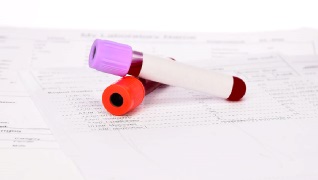
Animal Specimen Preparation
(package all specimens in ziplock bags separated from test request forms)

- Serum Tests: Draw blood into Serum Separator Tube and allow to stand in rack until well-clotted (typically 15-20 minutes). Spin in centrifuge for 5-10 minutes. Pour Serum into Red Top, White Top, or transport vial. Label with animal information. Refrigerate until packaging.
- Whole Blood: Draw blood into Lavender Top Tube. Mix well by slowly inverting tube 5-10 times. Label with animal information. Refrigerate until packaging.
- Urine: Pour or inject collected urine into White Top or Red Top Tube. Label with animal information. Refrigerate until packaging.
- Fecal: Place 2g (about the size of a grape) into stool container. Label with animal information. Refrigerate until packaging.
- Cytology Fluids: Centrifuge for 5-10 minutes. Make slides from concentrated fluid at bottom of tube. Label with animal information. Refrigerate fluid until packaging. Do Not Refrigerate Slides.
- Biopsy: Place tissue in appropriate size formalin jar. Label with animal information. Place jar in 2 sealed ziplock bags. Keep request form in outer pouch.
- Bacterial Cultures: Insert sterile swab of culturette into source and immerse in culture gel in transport tube. Label with animal information. Refrigerate until packaging.
- Fungal Cultures: Place cotton swab or toothbrush on source. Put into White Top Tube or Clean Ziplock Bag. Label with animal information. Refrigerate until packaging.
- PCR: Place cotton swab on source. Put into White Top Tube or Clean Ziplock Bag. Label with animal information. Refrigerate until packaging.
- Clarifications on specimen preparation. Call Lab at 714-258-0330.

Animal Specimen Shipping Address
Ship all specimens to:
Lore Animal Diagnostics
15052 Red Hill Avenue
Suite E
Tustin, CA 92780
Animal Specimen Shipping Regulations
The IATA (air transport) and Department of Transportation regulations allow some patient specimens to be exempt from Dangerous Goods requirements. These regulations apply to both air and ground transportation. Exempt substances do not require a Declaration of Dangerous Goods or hazardous material training. However, if the substance is shipped on dry ice, then the dangerous goods regulation for dry ice must be followed and training is still required.
Exempt patient specimens must be properly packaged.
Common Shipping Carrier Guideline Links:
For UPS guidelines to ship diagnostic specimens see http://www.ups.com/content/us/en/resources/ship/hazardous/biological_substances.html?srchpos=1&srch_phr=Diagnostic+Specimens
For FedEx guidelines see http://www.fedex.com/us/services/packageshipment/index.html?CMP=PAC-GTS-VURL008, click “Pack Like a Pro”, scroll down to “Get the Guides”.
For the U.S. Postal Service see http://pe.usps.com/text/pub52/pub52c3_021.htm Exempt Substances
The following are exempt from IATA's hazardous material regulations:
- Substances which do not contain infectious substances or substances which are unlikely to cause disease in humans or animals.
- Substances containing micro-organisms which are non-pathogenic to humans or animals.
- Patient specimens for which there is minimal likelihood that pathogens are present.
- Note: Patient specimens are material collected directly from animals, including, but not limited to, excreta, secreta, blood and its components, tissue and tissue fluid swabs, and body parts being transported for purpose such as research, diagnosis, investigational activities, disease treatment and prevention.
-
Note: In determining whether a patient specimen has a minimal likelihood that pathogens are present, an element of professional judgment is required to determine if a substance is exempt. That judgment should be based on the known medical history, symptoms and individual circumstances of the source and endemic local conditions. If there is any reason to suspect that the specimen contains a pathogen, it cannot be shipped as exempt from Class 6.2 Hazardous Material.
- Substances in a form that any present pathogens have been neutralized or inactivated such that they no longer pose a health risk.
- Environmental samples (including food and water samples) which are not considered to pose a significant risk of infection.
- Dried blood spots, collected by applying a drop of blood onto absorbent material, or fecal occult blood screening tests.
- Material collected for transfusion or transplantation.
Packaging Requirements for Exempt Animal Specimens

- Use a leak-proof primary receptacle.
- When multiple fragile primary receptacles are placed in a single secondary package they must be either individually wrapped or otherwise separated to prevent contact between them.
- For liquid specimens, place sufficient absorbent material between the primary and secondary package to be able to absorb the entire volume.
- Use a leak-proof secondary receptacle.
- Use an outer package of adequate strength for its capacity, mass and intended use.
- The outer package must have at least one surface with minimum dimensions of 100mm x 100mm. If the outer package is smaller, place it in a shipping envelope.
- Mark the outer package "Exempt Animal Specimen".
- For the FedEx Airbill question, "Does shipment contain dangerous goods?" check “NO”.



